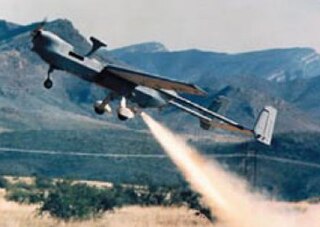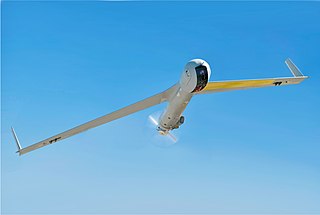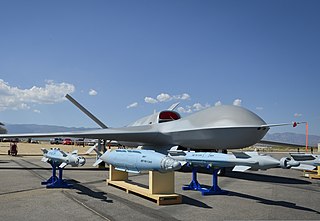Related Research Articles

The IAI RQ-5 Hunter unmanned aerial vehicle (UAV) was originally intended to serve as the United States Army's Short Range UAV system for division and corps commanders. It took off and landed on runways. It used a gimbaled EO/IR sensor to relay its video in real time via a second airborne Hunter over a C-band line-of-sight data link. The RQ-5 is based on the Hunter UAV that was developed by Israel Aerospace Industries.

The AAI RQ-7 Shadow is an American unmanned aerial vehicle (UAV) used by the United States Army, Australian Army, Swedish Army, Turkish Air Force and Italian Army for reconnaissance, surveillance, target acquisition and battle damage assessment. Launched from a trailer-mounted pneumatic catapult, it is recovered with the aid of arresting gear similar to jets on an aircraft carrier. Its gimbal-mounted, digitally stabilized, liquid nitrogen-cooled electro-optical/infrared (EO/IR) camera relays video in real time via a C-band line-of-sight data link to the ground control station (GCS).

An unmanned aerial vehicle (UAV), commonly known as a drone, is an aircraft without any human pilot, crew, or passengers on board. UAVs were originally developed through the twentieth century for military missions too "dull, dirty or dangerous" for humans, and by the twenty-first, they had become essential assets to most militaries. As control technologies improved and costs fell, their use expanded to many non-military applications. These include aerial photography, precision agriculture, forest fire monitoring, river monitoring, environmental monitoring, policing and surveillance, infrastructure inspections, smuggling, product deliveries, entertainment, and drone racing.

AeroVironment, Inc. is an American defense contractor headquartered in Arlington, Virginia, that designs and manufactures unmanned aerial vehicles (UAVs). Paul B. MacCready Jr., a designer of human-powered aircraft, founded the company in 1971. The company is best known for its lightweight human-powered and solar-powered vehicles. The company is the US military's top supplier of small drones —notably the Raven, Switchblade, Wasp and Puma models.

The Boeing Insitu ScanEagle is a small, long-endurance, low-altitude unmanned aerial vehicle (UAV) built by Insitu, a subsidiary of Boeing, and is used for reconnaissance. The ScanEagle was designed by Insitu based on the Insitu SeaScan, a commercial UAV that was intended for fish-spotting. The ScanEagle continues to receive improvements through upgrades and changes.

A miniature UAV, small UAV (SUAV), or drone is an unmanned aerial vehicle small enough to be man-portable. Smallest UAVs are called micro air vehicle.

Swift Engineering is an American spacecraft engineering firm that builds autonomous systems, helicopters, submarines, spacecraft, ground vehicles, robotics, and composite parts. Swift used to produce racing cars for open-wheel racing series, including Formula Ford, Formula Atlantic, the Champ Car World Series and Formula Nippon, having designed and fabricated over 500 race cars.

An electric aircraft is an aircraft powered by electricity. Electric aircraft are seen as a way to reduce the environmental effects of aviation, providing zero emissions and quieter flights. Electricity may be supplied by a variety of methods, the most common being batteries. Most have electric motors driving propellers or turbines.

The flight endurance record is the longest amount of time an aircraft of a particular category spent in flight without landing. It can be a solo event, or multiple people can take turns piloting the aircraft, as long as all pilots remain in the aircraft. The limit initially was the amount of fuel that could be stored for the flight, but aerial refueling extended that parameter. Due to safety concerns, the Fédération Aéronautique Internationale (FAI) no longer recognizes new records for the duration of crewed airplane or glider flights and has never recognized any duration records for helicopters.

The Elbit Hermes 450 is an Israeli medium-sized multi-payload unmanned aerial vehicle (UAV) designed for tactical long endurance missions. It has an endurance of over 20 hours, with a primary mission of reconnaissance, surveillance and communications relay. Payload options include electro-optical/infrared sensors, communications and electronic intelligence, synthetic-aperture radar/ground-moving target indication, electronic warfare, and hyperspectral sensors.

The Northrop Grumman Bat is a medium-altitude unmanned air vehicle originally developed for use by the United States Armed Forces. Designed primarily as an intelligence "ISR" gathering tool, the Bat features 30 lb (14 kg) payload capacity that is unmatched in a 10 ft (3.0 m) wing span.

The General Atomics MQ-1C Gray Eagle is a medium-altitude, long-endurance (MALE) unmanned aircraft system (UAS). It was developed by General Atomics Aeronautical Systems (GA-ASI) for the United States Army as an upgrade of the General Atomics MQ-1 Predator.

The BAE Systems Mantis Unmanned Autonomous System Advanced Concept Technology Demonstrator is a British demonstrator programme for Unmanned Combat Air Vehicle (UCAV) technology. The Mantis is a twin-engine, turboprop-powered UCAV with a wingspan of approximately 22 m, broadly comparable to the MQ-9 Reaper. Other partners involved in Phase 1 of the Mantis programme include the Ministry of Defence, Rolls-Royce, QinetiQ, GE Aviation, L-3 Wescam, Meggitt and Lola.

An high-altitude platform station or atmospheric satellite is a long endurance, high altitude aircraft able to offer observation or communication services similarly to artificial satellites. Mostly unmanned aerial vehicles (UAVs), they remain aloft through atmospheric lift, either aerodynamic like airplanes, or aerostatic like airships or balloons. High-altitude long endurance (HALE) military drones can fly above 60,000 ft over 32 hours, while civil HAPS are radio stations at an altitude of 20 to 50 km above a fixed point.

The General Atomics MQ-20 Avenger is a developmental unmanned combat aerial vehicle built by General Atomics Aeronautical Systems for the U.S. military.
PowerLight Technologies is an American engineering firm providing power transmission via lasers. Its primary products are power-over-fiber which transmits energy in the form of laser light through an optic fiber, and "laser power beaming" in which the laser energy is transmitted through free space.
The AeroVironment Global Observer is a concept for a high-altitude, long endurance unmanned aerial vehicle, designed by AeroVironment (AV) to operate as a stratospheric geosynchronous satellite system with regional coverage.
Packet Digital LLC, founded in 2003 and headquartered in Fargo, North Dakota, provides engineering services with expertise in power management, system integration, and product development. Packet Digital offers custom battery and charger design and assembly in the US. Packet Digital developed an autonomous power management system to achieve significant power savings. Their architecture is flexible and portable across multiple applications.

The TAI Aksungur is an unmanned aerial vehicle (UAV) built by Turkish Aerospace Industries (TAI) for the Turkish Armed Forces. Using existing technology from the TAI Anka series of drones, it is the manufacturer's largest drone with payload capacity for mission-specific equipment. It is intended to be used for long-term surveillance, signals intelligence, maritime patrol missions, or as an unmanned combat aerial vehicle. TAI planned to integrate weapon packages and put the Aksungur into production in early 2020. The first unit was delivered to the Turkish Naval Forces on 20 October 2021.
References
- ↑ "Unmanned, Virtually Unlimited".
- ↑ "Lockheed Martin Unveils the Stalker Mini-UAV for Special Forces Operations". Archived from the original on 2012-07-29. Retrieved 2012-07-12.
- 1 2 3 4 5 Chu, Kevin; Cook, Clifford; DeAnni, Anthony; Chu, Deryn (2019-05-13). Solid oxide fuel cell-powered Small Unmanned Aerial Systems (UASs) for extended endurance and long-range missions. Unmanned Systems Technology XXI. Vol. 11021. Society of Photo-Optical Instrumentation Engineers (SPIE). pp. 110210G. Bibcode:2019SPIE11021E..0GC. doi:10.1117/12.2518029 . Retrieved 16 July 2019.
- ↑ "Lockheed Martin Challenge: Flight control law build and test for a Vertical launch UAV (presentation)" (PDF).[ permanent dead link ]
- ↑ Visco, Steven; Jacobson, Craig; Villareal, Igor; Leming, Andy; De Jonghe, Lutgard C; Matus, Yuriy (2003). "Development of low-cost alloy supported SOFCs". Proceedings of the Electrochemical Society. 2003–07: 1040–1050. doi: 10.1149/200307.1040PV . S2CID 137740414.
- ↑ Walker, Michael. "Development of an Integrated Reformer and Fuel Cell System for Portable Power Applications" (PDF). S2CID 114044415. Archived from the original (PDF) on 16 July 2019. Retrieved 16 July 2019.
{{cite journal}}: Cite journal requires|journal=(help) - ↑ Kulkarni, A; Ciachic, FT; Giddey, S; Munnings, C; Badwal, SPS; Kimpton, JA; Fini, D (2012). "Mixed ionic electronic conducting perovskite anode for direct carbon fuel cells". International Journal of Hydrogen Energy. 37 (24): 19092–19102. doi:10.1016/j.ijhydene.2012.09.141.
- ↑ "Fuel Cell Handbook" (PDF). National Energy Technology Laboratory. Retrieved 16 July 2019.
- ↑ "Stalker EX Mini-UAV Set for Eight Hour Endurance Missions". 19 August 2011.
- ↑ Fuel cells increase range in unmanned aerial systems - Army.mil, 21 May 2015
- ↑ "Lockheed Martin and LaserMotive use laser to power UAV for 48 hours".
- ↑ Lockheed Martin Performs First Ever Outdoor Flight Test Of Laser Powered UAS - Lockheed Martin.com, August 7, 2012
- ↑ Lockheed Stalker offers improved endurance - Flightglobal.com, 13 August 2013
- ↑ Chu, Deryn; Jiang, Rongzhong. "Fuel Cell Powered Small Unmanned Aerial System (sUAS) Lessons Learned and the Road Ahead" (PDF). Retrieved 16 July 2019.
- ↑ "D350". Adaptive Energy. Retrieved 16 July 2019.
- ↑ Chu, Deryn; Jiang, Rongzhong. "Fuel Cell Powered Small Unmanned Aerial System (sUAS) Lessons Learned and the Road Ahead" (PDF). Retrieved 16 July 2019.
- ↑ Walker, Michael. "Development of an Integrated Reformer and Fuel Cell System for Portable Power Applications" (PDF). S2CID 114044415. Archived from the original (PDF) on 16 July 2019. Retrieved 16 July 2019.
{{cite journal}}: Cite journal requires|journal=(help) - ↑ "Fuel Cell Handbook" (PDF). National Energy Technology Laboratory. Retrieved 16 July 2019.
- ↑ "D350". Adaptive Energy. Retrieved 16 July 2019.